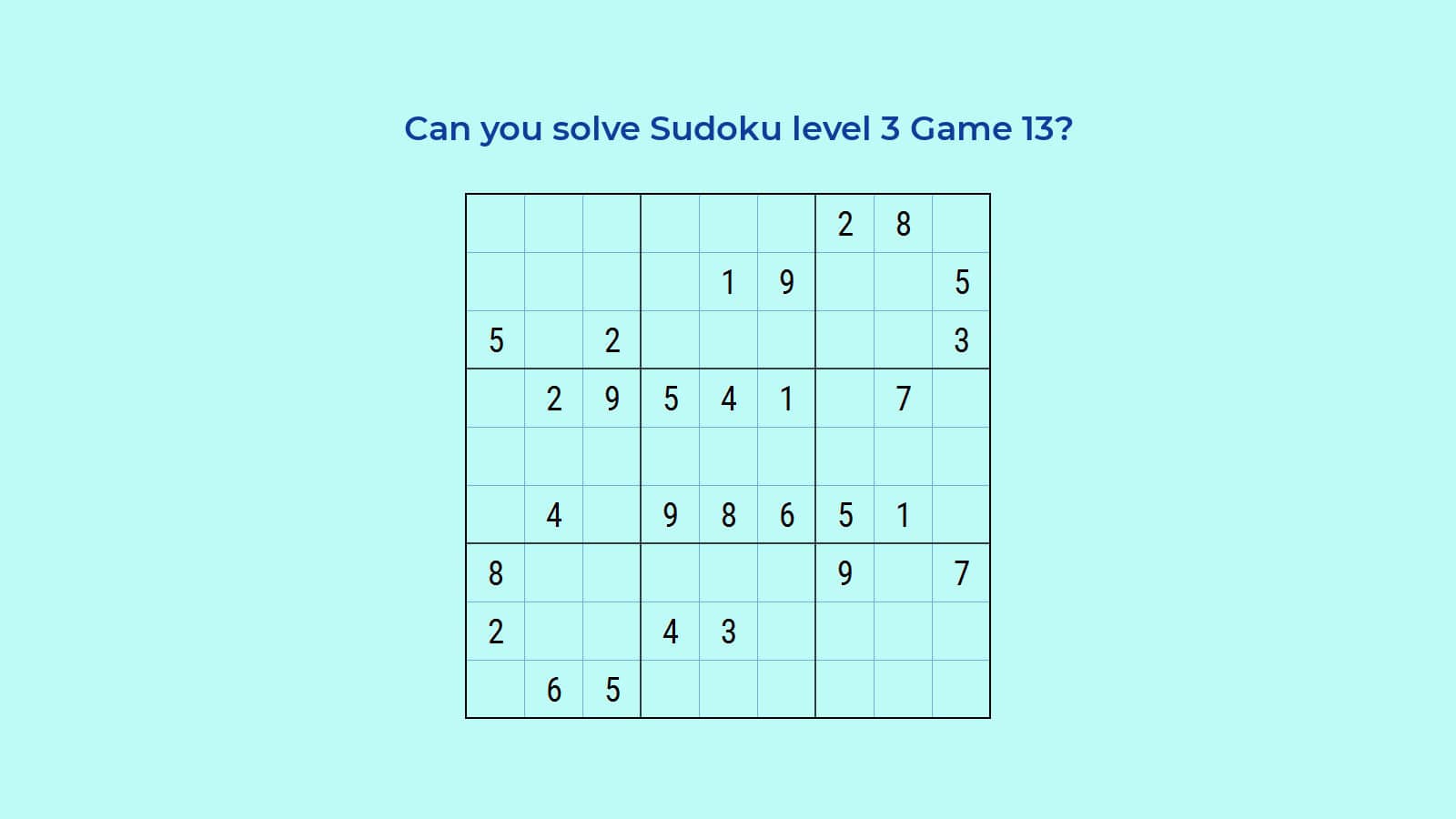
Step by step easy and quick solution to Sudoku level 3 game 13
This hard Sudoku level 3 game 13 is solved using simple and advanced Sudoku techniques step by step so that you understand clearly how to solve it yourself.
We'll solve the following Sudoku level 3 puzzle. First try to solve the puzzle before going through the solution.
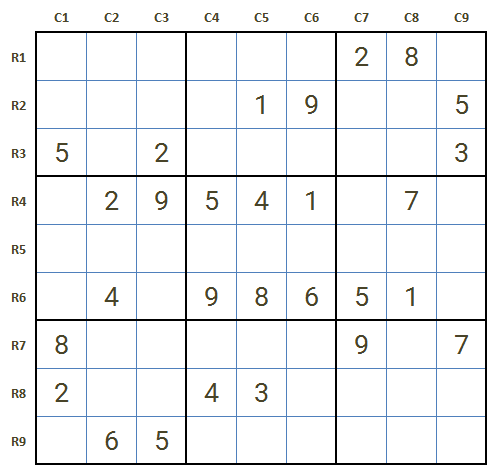
Strategy of solving a Sudoku hard puzzle
As a strategy, we'll always try to get a valid cell by row column scan first, by possible digit analysis or DSA second and by reduction caused by Cycles third. Cycles are valuable resources and we'll form a Cycle whenever we get the chance, even if it doesn't result in an immediate valid cell hit.
In addition we'll also use other advanced Sudoku techniques of single digit lock, parallel digit scan or X wing whenever we get the chance.
Evaluation of possible digit subsets for all empty cells is often prescribed as a must-do activity. We strongly recommend to avoid this time-consuming activity as far as possible and instead go in for filling up the empty cells by unique valid digits using Sudoku techniques needed.
The Sudoku techniques for solving this 13th hard Sudoku level 3 puzzle game are briefly but clearly explained along with the step by step solution. This hard Sudoku needed use of advanced techniques of single digit lock and parallel scan.
Let's go through the solution of the game.
Solution to Hard Sudoku level 3 game 13 Stage 1: Breakthrough by DSA technique, Single digit lock and Parallel scan

First valid digit by smallest digit scan is for 2: R2C4 2 by scan for 2 in R1, R3.
Followed by R6C9 2 by DSA reduction of [3,7] from row DS [2,3,7] in favorable row R6.
Cycle (3,7) in R6 and Cycle (2,3,7) in R5.
Characteristics of the Cycle (2,3,7) is explained below.
To skip the following section on Cycles click here.
Characteristics of the Cycle (2,3,7)
Observe that in the central middle major square six cells have already filled digits. So the three missing digits DS [2,3,7] must appear in the final solution in the three consecutive cells R5C4 with DS [3,7], R5C5 with DS [2,7], and R5C6 with DS [2,3,7].
We call this digit pattern as the Cycle of (2,3,7) in row R5.
Effectively, these three digits can be placed only in these three cells and in no other cell of the row.
If one of these cells, say R5C4 gets finally 7, R5C5 gets 2 and R5C6 get 3. Alternately, if R5C4 gets 3, the other two cells R5C5 and R5C6 may have either of [2,7]. In other words, if 3 is in R5C4, a new Cycle (2,7) is formed in rest of the cells R5C5 and R5C5.
This is as if these three digits Cycle through the three cells. That's why the name Cycle.
Okay, but what is the effect of a Cycle on the other digits in the empty cells of R5?
Because of the Cycle (2,3,7), it is a certainty that while carrying out valid cell analysis in the other six empty cells of R5 only the reduced set of six digits [1,4,5,6,8,9] are to be considered.
What are the conditions a Cycle must satisfy?
A proper Cycle of possible digit subsets or DSs in empty cells of a zone have the following characteristics:
- Number of digits in the Cycle must be same as number of cells involved in the Cycle. There may be two, three, four or higher digit long Cycles, two digit Cycles being more common and easier to identify.
- Each digit in a Cycle must appear in at least two cells involved in a Cycle.
- A Cycle may be formed in a column, a row or even in the cells of a major square without being in a row or column. In this last case, the Cycle will reduce the digits only in the DSs of the major square of the Cycle.
- The digits involved in a Cycle cannot appear in any cell outside the Cycle, thus reducing the DSs of empty cells in the Cycled zone. For example, in this case of Cycle (2,3,7), the possible digit subsets in all other empty cells of R5 are reduced by these three digits.
- A proper Cycle cannot contain a second smaller length Cycle. For example, if DSs of R5C5 and R5C6 were just [2,7] these two cells would have formed a smaller length Cycle reducing the DS of R5C4 to a direct valid cell hit of R5C4 3.
- A valid cell hit by a Cycle formation always would have an alternate way to get the valid cell hit by a Parallel scan. We would cite an example when explaining a parallel scan later. Often we don't form the Cycle and get a valid cell hit just by a quick bit of parallel scan.
Cycles are valuable assets to have for reducing the overall uncertainty in a Sudoku game.
Continuation 1 to hard Sudoku level 3 game 13 solution stage 1...
A series of valid cell hits next are by DSA technique.
Possible digit subset DS in left middle major square [1,5,6,8] and by DSA reduction of [1,5,8], R4C1 6 -- R4C9 8 by reduction of 3 -- R4C8 3 by exception in R4.
DS in three empty cells in left middle major square [1,5,8] and with [5,8] in C1, R4C1 1 by reduction of [5,8] -- R5C3 8 by reduction of 5 in C3 -- R5C2 5 by exception in left middle major square.
Identification and use of Sudoku technique of DSA explained below. To skip click here.
Finding a valid cell by Sudoku technique of possible digit subset analysis or DSA technique
DSA reduction technique is the short form of possible Digit Analysis Technique on empty cells of a zone that may be a row, a column or even a major square. Our objective would always be to get a unique digit in a valid cell, but if we don't get it we'll at least get short length possible digit subsets in the cells where we expect a valid cell.
In this game we have got such possible digit subsets [1,5,6,8] in the four empty cells of left middle major square. These four empty cells exclude the two cells involved in the Cycle (3,7).
At the second phase, for each cell, the other two parent zones (other than left middle major square) are examined to see how many of these four digits [1,5,6,8] are present in these two zones for each cell.
In this case, we get lucky for R4C1: the two other parent zones for R4C1 are R4 and C1. R4 has [1,5] and C1 has [8]; together these two zones have the existing digit subset [1,5,8]. The possible digit subset [1,5,6,8] for R4C1 is thus reduced to just a single digit 6 and we get the hit, R4C1 6.
This is the mechanism of finding a valid cell or a short length DS by possible digit subset analysis or DSA technique.
This is not generally considered to be an advanced hard Sudoku technique, but always be ready to use it whenever you can.
DSA technique is the basis for creating the possible digit subsets for empty cells in favorable zones. Naturally then, you should develop an eye for using this technique to create more useful digit patterns even if you don't get a unique digit for a valid cell.
Continuation 2 to solution of hard Sudoku level 3 game 13 stage 1...
We'll identify and use the digit pattern of parallel scan that avoids time-consuming Cycle formation by DSA on each cell.
R8C2 9 by parallel scan for 9 on empty cells of R8: 9 in bottom right major square eliminates three cells for 9 and 9 in C3 and C6 eliminate the other two empty cells of R8 leaving just R8C2 for 9.
R1C1 9 by scan for 9 in R2, C2, C3 -- R3C8 9 by scan for 9 in R1, R2, C7 -- and lastly R5C9 9 by scan for 9 in C7, C8. Digit 9 fully filled.
Cycle (4,6) formed in cells R2C8 and R5C8 by DSA reduction and that reduces 6 in DS [5,6] resulting in the valid cell R8C8 5.
R9C5 9 by scan for 9 in R7, R8, C4, C6. Digit 9 is fully filled.
Single digit lock on 8 formed in R3C4, R3C6 by cross-scan for 8 in R1, C5 -- R2C2 8 by scan for 8 in R1, locked 8 in R3, C1 and C3.
Game status at this first stage shown below.
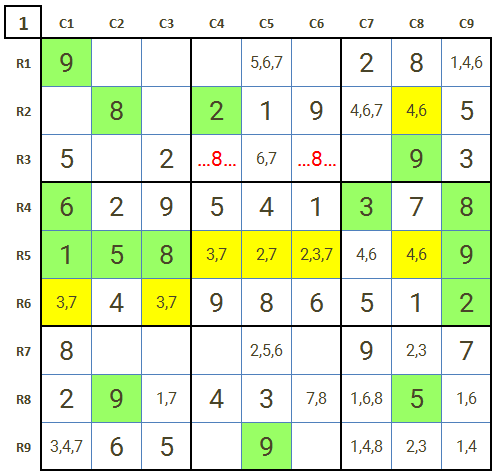
Before we start explaining the stage 2 of the solution let's look briefly into the Sudoku technique of Parallel digit scan.
To skip the following section on Parallel scan click here.
A note on what is a parallel digit scan and how to use it
A normal scan for a single digit is done on the empty cells of a favorable major square. The cell of the major square is explored for the possible unique digit that can be placed in a cell by examining the rows and columns intersecting the major square.
Parallel digit scan is also carried out for a single digit, but instead of doing the scan on the empty cells of a major square, in this special variation of the scan, the scan is carried out ON THE EMPTY CELLS OF A ROW OR A COLUMN with a goal to identify a single empty cell in the zone scanned where the digit scanned can be placed.
In this game, parallel digit scan is carried out for digit 9 on empty cells of row R8.
Observe that by the presence of 9 in bottom right major square, three cells in R8 are eliminated for 9 and because of 9 in C3 and C6 two more empty cells of R8 are eliminated for placement of 9. By these reductions, only the cell R8C2 is left where only digit 9 can be placed.
This valid cell hit of R8C2 9 could also have been identified by first forming a long 5 digit long Cycle of (1,5,6,7,8) in 5 empty cells of R8. As this is often time-consuming, we prefer looking out for the opportunity of a parallel scan which is quick and elegant.
Solution to the Sudoku level 3 game 13 Stage 2: Breakthroughs by Single digit lock and Cycles
By 4 in R8 and Cycle (4,6) in C8 a cross-scan on 4 happens to create the single digit lock on 4 in R9C7, R9C9 -- the lock reduces 4 in DS [3,47] in R9C1 to form the Cycle (3,7) with R6C1 -- R2C1 4 by reduction of [3,7] by the Cycle -- R2C8 6 by reduction -- R5C8 4 by reduction -- R5C7 6 by reduction -- R8C8 6 by scan in C7, C8 -- R1C3 6 by scan in R2, C2.
With 4 in R2C1, R2C7 7 by reduction -- R2C3 3 by exception in R2.
With 3 in R2C3, R6C3 7 by reduction -- R6C1 3 by reduction --- R9C1 7 by reduction -- R8C3 1 by reduction -- R7C3 4 by exception in C3 -- R7C2 3 by exception in bottom left major square -- R7C8 2 by reduction -- R9C8 3 by reduction.
Result of actions taken at this stage shown below.
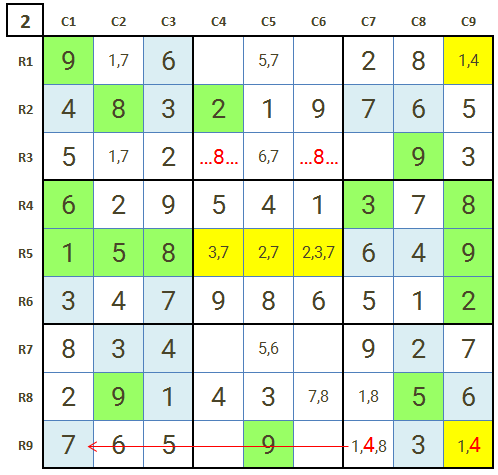
This time also before starting explanation of the final stage of solution, we'll briefly explain mechanism of a single digit lock.
To skip the following section on Single digit lock click here.
A note on breakthrough by Single digit lock
By CROSS-SCAN for 4 in R8 and C8, a single digit lock on 4 is formed in R9C7, R9C9. Digit 4 appears only in the possible digit subsets of these two cells in the bottom right major square and row R9.
In the final solution, one of these two must be present ensuring that digit 4 is prohibited in all other possible digit subsets of empty cells in R9.
Effectively this is as if digit 4 already exists in R9 and so it reduces the digit 4 in the possible digit subset [3,4,7] in R9C1 to transform it to just [3,7] which joins with DS [3,7] in R6C1 and forms a Cycle [3,7] in R1.
Finally, because of this Cycle that could be formed by reduction due to single digit lock on 4, we get the valid cell R2C1 4 by reduction of [3,7] from [3,7,4].
We classify this as an effective single digit lock that is formed either by scan of a single row or column or by cross-scan of a row and a column.
An effective single digit lock always will produce a breakthrough.
Solution to Hard Sudoku level 3 game 13 Final Stage 3: Now it's easy, all challenges taken care of
With 1 in R8C3 R8C7 8 by reduction -- R8C6 7 by reduction DS [2,8] in two empty cells of R9 and with 2 in C4, R9C4 8 by reduction of 2 -- R9C6 2 by exception -- R3C6 8 by reduction of its lock partner in R3C4.
DS [1,4,6,7] in R3, with [1,4] lighting up both R3C4, R3C5, Cycle (6,7) formed in these two cells -- R3C2 1 by reduction of 7 -- R1C2 7 by reduction.
R1C5 5 by reduction -- R7C5 6 by reduction -- R3C5 7 by reduction -- R5C5 2 by reduction -- R5C6 3 by reduction -- R5C4 7 by reduction -- R3C4 6 by reduction -- R3C7 4 by reduction -- R9C7 1 by reduction -- R9C9 4 by reduction.
R1C9 1 by reduction -- R7C4 1 by scan for 1 in C6 -- R7C6 5 by exception in R7 -- R1C4 3 by exception in C4 -- R1C6 4 by exception in whole game.
Final solution shown below.
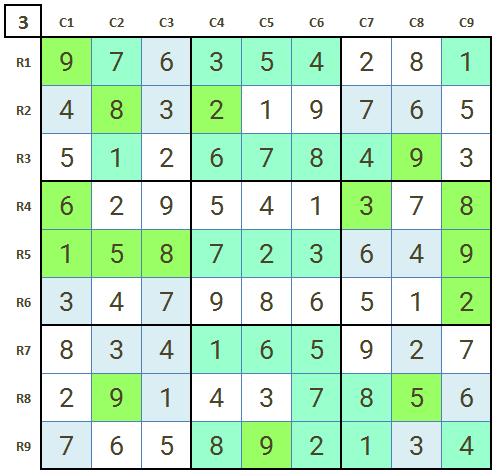
Check for the validity of the solution if you need.
End note
The breakthroughs in solving this hard Sudoku puzzle game could be achieved by using single digit lock twice and parallel scan once, apart from usual possible digit analysis or DSA technique and row column scan.
Though we have used the advanced Sudoku techniques, the general hardness of the puzzle is suitable for classifying it as a level 3 Sudoku hard puzzle.
Degree of difficulty at this third level of Sudoku hard puzzles is less than the Sudoku hard puzzles at level 4 possibly because of fairly large number 28 of filled cells in the game.
A Sudoku hard puzzle at level 4 would always have number of filled cells not more than 25 or at most 26. Even a difference of 1 filled cell may make a lot of difference in hardness of Sudoku puzzles when number of filled cells is a this range.
More Sudoku hard puzzles you may like to solve and learn how to solve
The updated list of Solutions to level 3, level 4 and NYTimes Sudoku hard puzzle games:
How to solve Sudoku hard puzzle games full list (includes very hard Sudoku).
Enjoy solving Sudoku hard.
By the way, Sudoku hard solution techniques are included with many of the solutions.
Enjoy also learning how to solve Sudoku hard in easy steps.
